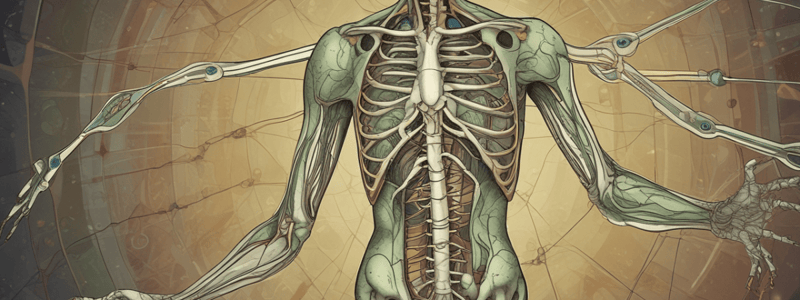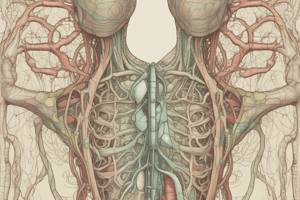Podcast
Questions and Answers
What is the primary function of the lymphatic system in defending the body?
What is the primary function of the lymphatic system in defending the body?
- To transport fats and fat-soluble vitamins from the digestive system only
- To produce antibodies and immune factors
- To remove waste and toxins from the body only
- To defend the body against disease-causing microorganisms and remove waste and toxins (correct)
Which of the following is NOT a component of the lymphatic system?
Which of the following is NOT a component of the lymphatic system?
- Lymph nodes
- Lymphoid organs
- Kidneys (correct)
- Lymphatic vessels
What is the direction of lymph flow in the lymphatic circulation?
What is the direction of lymph flow in the lymphatic circulation?
- From tissues to lymph nodes to lymphatic trunks to subclavian veins (correct)
- From lymphatic vessels to lymphoid organs
- From subclavian veins to lymph nodes
- From lymph nodes to tissues
What is the primary function of lymph nodes?
What is the primary function of lymph nodes?
Which lymphoid organ develops and matures immune cells?
Which lymphoid organ develops and matures immune cells?
What is lymphedema?
What is lymphedema?
What is the primary function of the spleen?
What is the primary function of the spleen?
What is the role of lymphatic vessels in lymphatic circulation?
What is the role of lymphatic vessels in lymphatic circulation?
What is the primary function of tonsils?
What is the primary function of tonsils?
What is the outcome of the immune response?
What is the outcome of the immune response?
What is the main function of the upper respiratory tract?
What is the main function of the upper respiratory tract?
Which of the following is a characteristic of the right lung?
Which of the following is a characteristic of the right lung?
What is the purpose of the cilia in the upper respiratory tract?
What is the purpose of the cilia in the upper respiratory tract?
During inspiration, what happens to the diaphragm?
During inspiration, what happens to the diaphragm?
What is the site of gas exchange in the lungs?
What is the site of gas exchange in the lungs?
What is the function of the intercostal muscles?
What is the function of the intercostal muscles?
What is the main function of the epiglottis?
What is the main function of the epiglottis?
What is the term for the maximum volume of air that can be exhaled after maximum inhalation?
What is the term for the maximum volume of air that can be exhaled after maximum inhalation?
What is the function of the ciliated mucous membrane in the trachea?
What is the function of the ciliated mucous membrane in the trachea?
What is the term for the process of exchanging oxygen and carbon dioxide in the alveoli?
What is the term for the process of exchanging oxygen and carbon dioxide in the alveoli?
What is the location of the lungs in the body?
What is the location of the lungs in the body?
What is the function of the brain's respiratory center?
What is the function of the brain's respiratory center?
Study Notes
Lymphatic System
Function:
- Defends the body against disease-causing microorganisms
- Aids in the removal of waste and toxins
- Transports fats and fat-soluble vitamins from the digestive system
Components:
- Lymphatic vessels (lymphatic capillaries, lymphatic vessels, and lymphatic trunks)
- Lymph nodes (filter lymph and trap pathogens)
- Lymphoid organs (spleen, thymus, and tonsils)
- Lymphatic tissues (lymphoid follicles and mucosa-associated lymphoid tissue)
Lymphatic Circulation:
- One-way flow: lymph flows from tissues to lymph nodes to lymphatic trunks to subclavian veins
- Lymphatic vessels have one-way valves to prevent backflow
- Lymphatic circulation is aided by muscle contractions and breathing
Lymph Nodes:
- Filtering lymph to remove pathogens and foreign substances
- Activating immune responses
- Found in neck, axilla, groin, and abdominal regions
Lymphoid Organs:
- Spleen:
- Filters blood to remove pathogens and foreign substances
- Stores red blood cells and platelets
- Acts as a reservoir for blood
- Thymus:
- Develops and matures immune cells (T-lymphocytes)
- Produces thymic hormones to regulate immune function
- Tonsils:
- Traps pathogens and foreign substances in the oral cavity
- Activates immune responses
Lymphatic System Disorders:
- Lymphedema (swelling due to lymphatic vessel obstruction)
- Lymphadenitis (lymph node inflammation)
- Lymphoma (cancer of lymphatic tissue)
- Spleen disorders (e.g., splenomegaly, splenectomy)
Immune Response:
- Recognizes and responds to pathogens and foreign substances
- Involves activation of immune cells (T-lymphocytes, B-lymphocytes, and macrophages)
- Produces antibodies and immune factors to combat infection
Lymphatic System Function
- Defends the body against disease-causing microorganisms
- Aids in the removal of waste and toxins
- Transports fats and fat-soluble vitamins from the digestive system
Components
- Lymphatic vessels: lymphatic capillaries, lymphatic vessels, and lymphatic trunks
- Lymph nodes: filter lymph and trap pathogens
- Lymphoid organs: spleen, thymus, and tonsils
- Lymphatic tissues: lymphoid follicles and mucosa-associated lymphoid tissue
Lymphatic Circulation
- One-way flow: lymph flows from tissues to lymph nodes to lymphatic trunks to subclavian veins
- Lymphatic vessels have one-way valves to prevent backflow
- Lymphatic circulation is aided by muscle contractions and breathing
Lymph Nodes
- Filter lymph to remove pathogens and foreign substances
- Activate immune responses
- Found in neck, axilla, groin, and abdominal regions
Lymphoid Organs
- Spleen: filters blood to remove pathogens and foreign substances, stores red blood cells and platelets, and acts as a reservoir for blood
- Thymus: develops and matures immune cells (T-lymphocytes), produces thymic hormones to regulate immune function
- Tonsils: trap pathogens and foreign substances in the oral cavity, activate immune responses
Lymphatic System Disorders
- Lymphedema: swelling due to lymphatic vessel obstruction
- Lymphadenitis: lymph node inflammation
- Lymphoma: cancer of lymphatic tissue
- Spleen disorders: e.g., splenomegaly, splenectomy
Immune Response
- Recognizes and responds to pathogens and foreign substances
- Involves activation of immune cells (T-lymphocytes, B-lymphocytes, and macrophages)
- Produces antibodies and immune factors to combat infection
Respiratory System Overview
- Bringing oxygen into the body and removing carbon dioxide are the two primary functions of the respiratory system.
- The system consists of the upper and lower respiratory tracts.
Upper Respiratory Tract
- The nose, mouth, pharynx, and larynx make up the upper respiratory tract.
- Warms, humidifies, and filters the air we breathe are the three primary functions of the upper respiratory tract.
- Small hair-like structures called cilia are found in the upper respiratory tract and help remove dust and debris.
Lower Respiratory Tract
- The trachea, bronchi, bronchioles, and lungs comprise the lower respiratory tract.
- Bringing oxygen into the lungs and removing carbon dioxide are the two primary functions of the lower respiratory tract.
- The lower respiratory tract facilitates the exchange of gases between the air we breathe and the bloodstream.
Lungs
- The lungs are located in the thoracic cavity.
- The right lung has three lobes, while the left lung has two.
- The lungs facilitate the exchange of oxygen and carbon dioxide through the process of respiration.
- The lungs contain alveoli, small air sacs where gas exchange occurs.
Respiratory Muscles
- The diaphragm is a dome-shaped muscle that separates the chest cavity from the abdominal cavity.
- The intercostal muscles are located between the ribs and help expand and contract the chest cavity.
- The diaphragm and intercostal muscles work together to expand and contract the chest cavity, allowing air to enter and leave the lungs.
Respiratory Process
- Inspiration occurs when the diaphragm contracts and flattens, and the intercostal muscles contract and expand the chest cavity, allowing air to enter the lungs through the mouth or nose.
- Expiration occurs when the diaphragm relaxes and rises, and the intercostal muscles relax and the chest cavity decreases in size, causing air to leave the lungs through the mouth or nose.
Gas Exchange
- Oxygen from the air we breathe diffuses into the bloodstream through the alveoli.
- Carbon dioxide from the bloodstream diffuses into the alveoli and is exhaled.
- Oxygen is transported to the body's cells, while carbon dioxide is removed.
Respiratory System Overview
- Responsible for bringing oxygen into the body and removing carbon dioxide
- Consists of the nose, mouth, throat, lungs, and trachea
Organs and Structures
- Nose and Mouth:
- Filter, warm, and humidify air
- Contain small hairs (cilia) and mucous membranes to trap dust and bacteria
- Throat (Pharynx):
- Shared passage for food and air
- Contains epiglottis, which separates food and air passages
- Larynx (Voice Box):
- Contains vocal cords for sound production
- Epiglottis separates larynx from esophagus
- Trachea (Windpipe):
- Tube that connects larynx to bronchi
- Ciliated mucous membrane and cartilage rings provide structure and protection
- Bronchi and Bronchioles:
- Tubes that branch off from trachea to lungs
- Divide into smaller bronchioles, eventually forming alveoli
- Lungs:
- Located in thoracic cavity, surrounded by rib cage
- Right lung has three lobes, left lung has two
- Diaphragm:
- Dome-shaped muscle that separates chest cavity from abdominal cavity
- Contracts and relaxes to facilitate breathing
Functions
- Breathing:
- Inspiration (inhalation): diaphragm contracts, rib cage expands, air enters lungs
- Expiration (exhalation): diaphragm relaxes, rib cage descends, air leaves lungs
- Gas Exchange:
- Oxygen diffuses into blood in alveoli
- Carbon dioxide diffuses out of blood in alveoli
- Regulation:
- Brain's respiratory center controls breathing rate
- Chemoreceptors detect changes in CO2 and O2 levels, adjusting breathing accordingly
Important Concepts
- Respiratory Rate: number of breaths per minute
- Tidal Volume: volume of air inspired or expired with each breath
- Vital Capacity: maximum volume of air that can be exhaled after maximum inhalation
Studying That Suits You
Use AI to generate personalized quizzes and flashcards to suit your learning preferences.
Description
Learn about the functions and components of the lymphatic system, including its role in defending the body against disease and removing waste and toxins.




